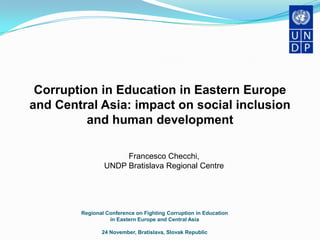
Corruption in Education in Eastern Europe and Central Asia impact on social inclusion and human development
- 1. Corruption in Education in Eastern Europe and Central Asia: impact on social inclusion and human development Francesco Checchi, UNDP Bratislava Regional Centre Regional Conference on Fighting Corruption in Education in Eastern Europe and Central Asia 24 November, Bratislava, Slovak Republic
- 2. UNDP anti corruption effort in the region
- 3. Reasons for engaging on anti corruption in sectors 1) Criticism of the “traditional’ approach to fighting corruption 2) Basic service delivery (health- education) one of the areas where corruption mostly occurs TI global corruption Barometer – 2010 Data from NIS percentage of people reporting bribes 40 35 30 25 20 15 percentage of people reporting bribes 10 5 0
- 4. Reasons for engaging on anti corruption in sectors 3) There is a lot of work still to be done: corruption in sectors still to be assessed in many countries little systemisation of good practices and lessons learned from anti-corruption activities in basic public service Few programmes addressing the issue in the region 4) The value added of addressing corruption in sectors : Utilization of sector expertise and AC expertise Address specific corruption patterns in the sectors
- 5. Human development and anti corruption: making the link human development goal of the development assistance, social inclusion = tool to achieve HD Education is the key sector for social inclusion Corruption is an obstacle (barrier) for educationally deprived people to make choices and limits their freedoms to get access to knowledge . It leads to social exclusion of uneducated people. Fight against corruption in education contributes to promotion of social inclusion (inviting for more equal access to education, promoting knowledge-based society, improving quality of human capital)
- 6. Education and social inclusion Social exclusion = inability to participate process and an outcome (access to goods and rights) Drivers and risks Exclusion from - Inclusion in Economic life Education Corrup system tion Civic and social life and networks Structural deficiencies Social services
- 7. Corruption – education – social exclusion Corruption in education > 1. Waste and unequal use of educational resources at various levels: (from the central to the local government - from local government to schools and teachers - from schools and teachers to the students) 2. Misallocation of talents 3. Propagating culture of corruption Social Exclusion drivers: structures and institutions, values and behavioral Social exclusion risk patterns and policies factors: individual developed in culture of corruption will characteristics (lack not be able to promote social inclusion or of education) to address the issue of corruption
- 8. Evidence from the region Source: Regional Human Development Report “Beyond Transition. Towards Inclusive Societies” , UNDP 2011
- 10. Tolerance of corruption Social exclusion index by dominating values (tolerance to corruption) and type of settlement 30 25 Low acceptance of unofficial payments for 20 services or for getting business done 15 10 High acceptance of unofficial payments for services or for getting 5 business done 0 Villages Small towns Capital Source: Social Exclusion Survey 2009
- 12. Multidimensional Poverty Approach Same UNDP/OPHI approach as used for Global HDR 2010 for poverty „Dual cutoff‟ method: within dimension: based on deprivation with respect to given dimension across dimensions: overall threshold (number of deprivations) beyond which a person is considered socially excluded
- 13. Three dimensions of social exclusion (with 8 indicators each): Economic: Deprivation in incomes, basic needs, access to employment, financial services; material needs and lack of amenities; housing and ICT-related exclusion. Social services: Access to and affordability of education and health services; other public services, such as public utilities. Participation: Deprivation in political, cultural and social participation; political, cultural and social support networks.
- 14. Tough measurement question: How many deprivations does it take to be excluded? Threshold-number of deprivations, a matter of choice Our survey: 9 14
- 15. The cut-off line affects the share of excluded, but not countries‟ relative standing Social exclusion headcount for three different thresholds 100 90 Percentage of people considered 'socially excluded' 80 threshold 70 Kazakhstan for each cutoff value 60 Moldova FYR 50 Macedonia Serbia 40 Tajikistan 30 Ukraine 20 10 0 1 2 3 4 5 6 7 8 9 10 11 12 13 14 15 16 17 18 19 20 21 22 23 24 Deprivation cutoff value
- 16. individual dimensions to overall exclusion FYR Kaz. Moldova Macedonia Serbia Tajikistan Ukraine A. Economic 34% 32% 30% 31% 39% 28% exclusion B. Exclusion from 34% 39% 38% 38% 34% 36% social services C. Exclusion from 32% 30% 32% 31% 27% 36% participation in civic and social life and networks
